wav 格式音频文件生成例子
wavfile is a simple sound library for use in CSE 20211. This library allows you to generate arbitrary sound waveforms in an array, then write them out to a standard WAV format file, which can then be played back by almost any kind of computer.
Note: As a courtesy to others in the course or the lab, please use headphones when working with sounds.
Digital Sound Primer
A computer generates digital sounds by creating a digital waveform. A waveform is simply a sequence of digital values that describe how a speaker is to be physically pulsed by an digital-to-analog (DAC) converter. Positive values in the waveform indicate the speaker is to be pushed slightly outward, creating positive air pressure, while negative values indicate the speaker is to be pulled slightly inward, creating negative air pressure.
The sampling rate of a digital sound indicates how many digital values are used per second of playback. The standard for CD-quality sound is a sampling rate of 44.1KHz. The volume of a digital sound is simply the amplitude of the waveform: bigger changes mean louder sounds.
The character and quality of a sound is entirely described by the shape of its waveform. Try clicking on the waveforms below to see what they sound like. A sine wave is smooth and open, like a flute. A square wave is piercing, like a smoke alarm. A triangle wave sounds rather brassy. The random wave sounds like white noise.
Sine Wave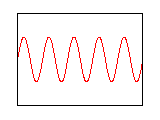 |
Square Wave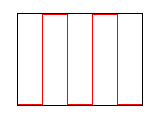 |
Triangle Wave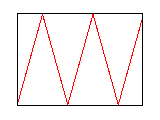 |
Random Wave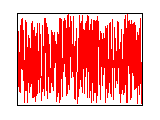 |
A sound with a regular pattern has a fundamental frequency which is the number of peaks in the waveform per second. The sine, square, and triangle waves above all have a frequency of 440Hz, which is a concert-A pitch. (Note also that the frequency is not the same as the sampling rate.)
Most sounds in the real world are not as clean and simple as the waveforms above. Instead, they are a sum of multiple waveforms at different frequencies. Musical instruments tend to produce a strong waveform at the pitch actually played. This is known as the fundamental frequency. At the same time, they also produce quieter sounds at integer multiples of the fundamental frequency, known has harmonics.
For example, click on the three sounds below. The first is a sine wave at 440Hz. The second adds a harmonic at 880Hz. The third adds another harmonic at 1760 Hz. If you listen carefully, you will see that the sounds with more harmonics are more pleasant and more realistic. (I think it sounds like a pipe organ.)
| Fundamental Frequency |
Fundamental + 1 Harmonic |
Fundamental + 2 Harmonics |
|---|---|---|
 |
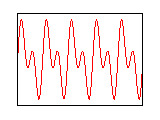 |
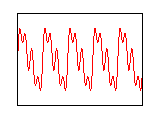 |
Getting Started
It is very easy to generate waveforms like those above to create digital sounds and (eventually) music. To get started, download the following files:
And compile them together as follows:
Then, run the example program:
The program creates a file called sound.wav. To play back the file on Linux, use the play command:
How it Works
The sound library only has three functions:
wavfile_open creates a new file whose name is given by the first argument. It automatically puts the standard WAV header into the file for you. If successful, it returns a pointer to a FILE object. If unsucessful, it returns null.
wavfile_write writes data to an open file. The first argument must be a pointer to a FILE object returned by wavfile_open. The second argument is an array of waveform data, and the third argument is the number of samples to write. This function may be called multiple times to add more sounds to an open wavfile.
wavfile_close completes writing to a wavfile. It is required to call wavfile_close when your sound is complete, otherwise the file will not be usable.
Finally, the header contains a constant WAVFILE_SAMPLES_PER_SECOND which indicates how many samples are in a waveform per second of playback.
Example Program
The program example.c creates a simple wavfile that plays a sine-wave for one second. It works as follows:
First, an array of shorts is created to hold a waveform that will last for two seconds:
short waveform[NUM_SAMPLES];
For clarity, we define a few variables to indicate the frequency and volume of the sound. 440Hz is a concert A pitch, and the volume of the waveform is simply the amplitude, which can be up to 32768.
int volume = 32000;
Then, we fill the array with a sine wave of the desired frequency:
for(i=0;i<NUM_SAMPLES;i++) {
double t = (double) i / WAVFILE_SAMPLES_PER_SECOND;
waveform[i] = volume*sin(frequency*t*2*M_PI);
}
Finally, we use the wavfile library to write out the waveform to a file:
wavfile_write(f,waveform,length);
wavfile_close(f);
Using the simple sound library, writing out the sound file is easy. All of the challenge lies in constructing a waveform that plays the desired sound.
转自:
https://www3.nd.edu/~dthain/courses/cse20211/fall2013/wavfile/
wav 格式音频文件生成例子的更多相关文章
- (原创)speex与wav格式音频文件的互相转换
我们的司信项目又有了新的需求,就是要做会议室.然而需求却很纠结,要继续按照原来发语音消息那样的形式来实现这个会议的功能,还要实现语音播放的计时,暂停,语音的拼接,还要绘制频谱图等等. 如果是wav,m ...
- (原创)speex与wav格式音频文件的互相转换(二)
之前写过了如何将speex与wav格式的音频互相转换,如果没有看过的请看一下连接 http://www.cnblogs.com/dongweiq/p/4515186.html 虽然自己实现了相关的压缩 ...
- c#使用SoundPlayer播放wav格式音频
1.引用System.Media名称空间下的类SoundPlayer SoundPlayer player = new SoundPlayer(); 2.方法调用Play(); public vo ...
- 调用CImg库显示WAV格式音频波形
最近在做傅里叶变换和小波变换时经常要通过显示波形来检验算法,但通过visual studio之类显示波形又显得麻烦,而且不能跨平台. CImg是一个跨平台的C++的图像处理库,提供的图像处理等功能十分 ...
- ffmpeg 合并aac格式音频文件
1:连接到一起 'ffmpeg - i "concat:D:\learn\audio\1.aac|D:\learn\audio\2.aac" - acodec copy D:\le ...
- S3C2416裸机开发系列19_Fatfs播放录像wav音频文件
S3C2416裸机开发系列19 Fatfs播放录像wav音频文件 国际象棋男孩 1048272975 多媒体资源,一般都是以文件的形式存储在固化存储器中.Fatfs所支持的fat32为windo ...
- 解析WAV音频文件----》生成WAV音频文件头
前言:请各大网友尊重本人原创知识分享,谨记本人博客:南国以南i WAV音频文件介绍: WAV文件是在PC机平台上很常见的.最经典的多媒体音频文件,最早于1991年8月出现在Windows3.1操作系统 ...
- WAV格式文件无损合并&帧头数据体解析(python)(原创)
一,百度百科 WAV为微软公司(Microsoft)开发的一种声音文件格式,它符合RIFF(Resource Interchange File Format)文件规范,用于保存Windows平台的音频 ...
- Android 音视频开发(一):PCM 格式音频的播放与采集
什么是 PCM 格式 声音从模拟信号转化为数字信号的技术,经过采样.量化.编码三个过程将模拟信号数字化. 采样 顾名思义,对模拟信号采集样本,该过程是从时间上对信号进行数字化,例如每秒采集 44100 ...
- .NET winform播放音频文件
前提:最近要求做一个在winform端做一个音频文件播放的功能,至此,总结最近搜寻的相关资料. 一.微软提供了三种方式来播放音频文件 1.通过System.Media.SoundPlayer来播放 2 ...
随机推荐
- 辣鸡 mac 下 pycharm 中代码拖拽的问题
Editor –> General Enable Drag'n'Drop functionality in Editor
- 天玑9300大战骁龙8 Gen3:十余项数据实测 到底谁才是安卓之王?
一.前言:全大核天玑9300正面硬钢骁龙8 Gen3 究竟谁才是安卓芯片之王? 今年,两家移动芯片厂商都开始放大招了,骁龙首发Cortex-X4超大核,联发科也不甘示弱,初次将"全大核&qu ...
- SSD数据不能恢复?或许还有的救
我们经常说机械硬盘相对于固态硬盘的一个优势是数据可以恢复,难道SSD固态硬盘的数据就不能恢复了吗? 这里先简单介绍一下SSD的工作方式,SSD中的数据是以电子的形式通过浮栅保存的,写入就是通过增加电压 ...
- 最新版Emlog采集发布插件-免费下载
推荐一款可以自动采集网页文章数据,并发布到Emlog网站的Emlog采集发布插件(兼容最新的Emlog Pro版本,也兼容之前的 Emlog 5.3 和 Emlog 6.0 版本),支持对接简数采集器 ...
- npm script 详解,tsc && electron . 直接编译后 运行,非常方便
最终平时只需要用这个方法就可以了: tsc && electron . ======================================================== ...
- Linux-使用cat查看文件后出现乱码,整个终端显示包括shell提示符都是乱码
问题描述:在bash下用cat显示二进制文件后会出现乱码,整个终端显示包括shell提示符都是乱码,这个跟语言环境无关. 解决办法: 恢复的话,大致有以下几种方法:方法一:盲打输入echo -e '\ ...
- MySQL8.0-CTE递归查询(避免死循环)
TSQL脚本能实现递归查询,用户使用共用表表达式 CTE(Common Table Expression),只需要编写少量的代码,就能实现递归查询. 本文详细介绍CTE递归调用的特性和使用示例,递归查 ...
- Java-获取当前时间并进行格式化
获取年月日 时分秒 import java.text.SimpleDateFormat; import java.util.Date; Date dt = new Date(); SimpleDate ...
- JS leetcode 宝石与石头 题解分析,正则字符组也有妙用
壹 ❀ 引 简单问题简单做,今天的题目来自leetcode771. 宝石与石头,字符串相关的一道题,题目描述如下: 给定字符串J 代表石头中宝石的类型,和字符串 S代表你拥有的石头. S 中每个字符代 ...
- 惠普HP519打印机缺色处理记录
打印蓝色缺失, 黑色出墨不均匀 开盖检查, 发现蓝色墨水管路中间有断线, 拆开打印头后, 用随机器配的桔红色吸墨器吸墨. 之后重新开机还是缺色. 检查彩色打印头, 用浅浅的一层热水泡下方喷嘴, 黄色红 ...
